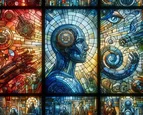Makers
Say you're looking for a new house, but no house in the area is built the way you want it. You have enough funds to invest in your house. What is a wise decision? Buy a plot of land and start building your own house! We see the same in the ever-evolving world of AI. You might need an AI solution that is so specific that no other existing solutions meet your needs. Or you might need absolute control over the entire process and architecture. Then you could build your own model and you will be a Maker.
Creating your own model involves building it from scratch, using readily available tools — similar to how wood and bricks are used in constructing a house. This means having all the freedom on model architecture and training techniques, perfectly suiting your needs. However, creating your own model also means supplying all the data for model training, testing and evaluation. Supplying all this data is very resource intensive, especially for large and powerful models that require enormous amounts of data.
For example, Meta AI's latest language model (Llama3), is claimed to be trained on over 15 trillion tokens*. Yes, that is 15 with 12 zeros, or 15.000.000.000.000, tokens. This is equivalent to the length of approximately 5 million bibles! This much data is difficult to collect and clean, but you can use pre-constructed datasets.
The internet has many open-source datasets, some of which you may use for commercial applications. It is important to verify the intellectual property rights of datasets, as there have been numerous examples of lawsuits against organizations regarding the unauthorized use of their data. One of the most well-known players in the AI industry, OpenAI, also faces multiple lawsuits against them and their partners including Microsoft. Scraping content to generate datasets may violate copyright or intellectual property rights, particularly when the content comes from protected sources. Even if the content is publicly available, scraping it for commercial use remains restricted.
* A token represents a basic unit of characters. It can be a single character, a word, or even punctuation.
💡 While pre-constructed datasets are available, be cautious about intellectual property rights and avoid scraping content for commercial use.
Responsible Usage (unacceptable risk)
According to the EU AI Act, AI models are classified into categories based on risk. One of these categories is ‘unacceptable risk’. According to "Article 5: Prohibited Artificial Intelligence Practices” AI models in the category of ‘unacceptable risk’ are forbidden to be published or used. Using them is considered a clear threat to people's safety, livelihoods, and rights. Needless to say, but when creating a new AI model, make sure that your model does not fall into the category of ‘unacceptable risk’.
One of the prohibited AI practices is ‘the placing on the market, the putting into service for this specific purpose, or the use of AI systems to infer emotions of a natural person in the areas of workplace and education institutions, except where the use of the AI system is intended to be put in place or into the market for medical or safety reasons’.
Some AI systems are so advanced that they can look at a person’s face and guess how that person is feeling. This might be done by looking at whether the person is smiling or frowning. However, the EU AI Act prohibits the creation, publication, and use of such AI models in certain places - specifically at work or at school. So, for example, your manager cannot use an AI system to guess if you are happy or sad while you are at work. The only time when it is okay to use these kinds of AI systems is for medical or safety reasons.
To determine whether to be a Taker, Shaper, or Maker, you must evaluate the proposed use of the AI model. Here are some example questions to determine which archetype to adopt:
- Do we have the necessary expertise to develop or customize AI models?
- Is there an existing product that already/adequately meets our needs?
- What is our budget for AI implementation?
- How critical is the need for the customization to our application, business, or processes?
- What are our strategic goals with AI?



